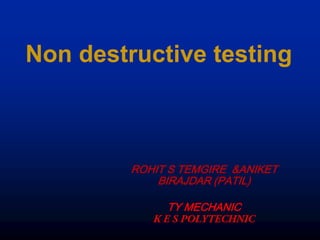
Nondestructive Testing Methods Explained in 40 Characters
- 1. Non destructive testing ROHIT S TEMGIRE &ANIKET BIRAJDAR (PATIL) TY MECHANIC
- 3. Definition of NDT The use of noninvasive techniques to determine the integrity of a material, component or structure or quantitatively measure some characteristic of an object. i.e. Inspect or measure without doing harm.
- 4. Type of Nondestructive Testing
- 5. What are Some Uses of NDE Methods? • Flaw Detection and Evaluation • Leak Detection • Location Determination • Dimensional Measurements Fluorescent penetrant indication • Structure and Microstructure Characterization • Estimation of Mechanical and Physical Properties • Stress (Strain) and Dynamic Response Measurements • Material Sorting and Chemical Composition Determination
- 6. Common Application of NDT • Inspection of Raw Products • Inspection Following Secondary Processing • In-Services Damage Inspection
- 7. Visual Inspection Most basic and common inspection method. Tools include fiberscopes, borescopes, magnifying glasses and mirrors. Portable video inspection unit with zoom allows inspection of large tanks and vessels, railroad tank cars, sewer lines. Robotic crawlers permit observation in hazardous or tight areas, such as air ducts, reactors, pipelines.
- 8. Liquid penetrant testing 1. Section of material with a surface-breaking crack that is not visible to the naked eye. 2. Penetrant is applied to the surface. 3. Excess penetrant is removed. 4. Developer is applied, rendering the crack visible 2
- 9. Liquid Penetrant Inspection
- 10. Radiography The radiation used in radiography testing is a higher energy (shorter wavelength) High Electrical Potential version of the electromagnetic waves that we see as visible light. The radiation can Electrons come from an X-ray generator or a + - radioactive source. X-ray Generator or Radioactive Source Creates Radiation Radiation Penetrate the Sample Exposure Recording Device
- 11. Film Radiography The part is placed between the radiation source and a piece of film. The part will stop some of the radiation. Thicker and more dense area will stop more of the radiation. The film darkness (density) will vary with the amount of radiation X-ray film reaching the film through the test object. = less exposure = more exposure Top view of developed film
- 13. Ultrasonic Inspection (Pulse-Echo) High frequency sound waves are introduced into a material and they are reflected back from surfaces or flaws. Reflected sound energy is displayed versus time, and inspector can visualize a cross section of the specimen showing the depth of features that reflect sound. f initial pulse back surface echo crack echo crack 0 2 4 6 8 10 plate Oscilloscope, or flaw detector
- 14. Eddy Current Testing Coil's Coil magnetic field Eddy current's magnetic field Eddy currents Conductive material
- 16. →Introduction of the Magnetic Field: 1.Using a permanent magnet or an electromagnet that contacts the test piece 2.Flowing an electrical current through the specimen 3.Flowing an electrical current through a coil of wire around the part or through a central conductor running near the part.
- 17. Power Plant Inspection Periodically, power plants are shutdown for inspection. Inspectors feed eddy current probes into heat exchanger tubes to check for corrosion damage. Pipe with damage Prob e Signals produced by various amounts of corrosion thinning.
